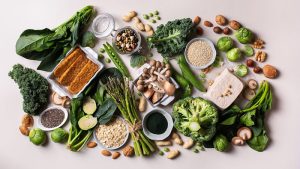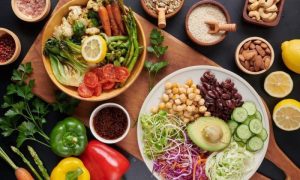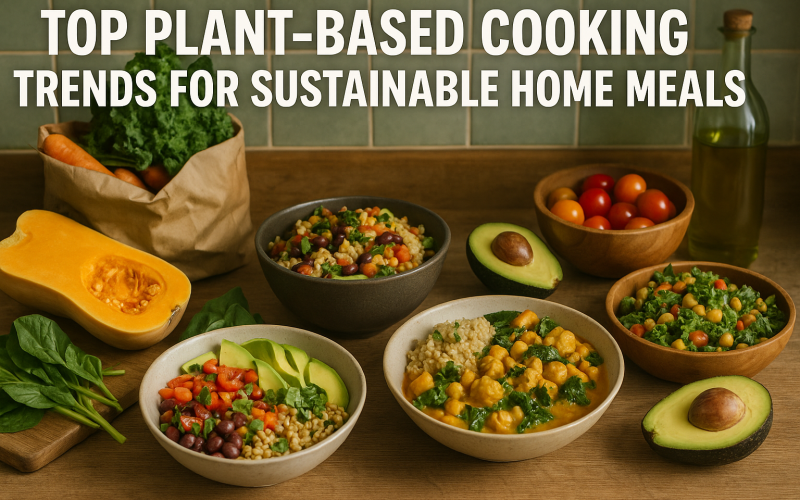Introduction
Cooking at home has changed in recent years. More people want meals that taste great and help the planet. Plant-based cooking offers both benefits. It uses fruits, vegetables, grains, legumes, nuts, and seeds. These ingredients feed our bodies and leave a smaller carbon footprint. In 2025, new sustainable cooking trends are making it easier than ever to prepare home meals that are eco-friendly and delicious. From meat alternatives that look like the real thing to smart kitchen gadgets that cut waste, cooking at home can now be part of a green lifestyle. This article explores the top plant-based cooking trends shaping sustainable home meals. You will learn key ideas, practical tips, and how to bring these trends into your own kitchen.
What is Plant-Based Cooking?
Plant-based cooking means building meals mainly around foods from plants. It does not require you to be fully vegan or vegetarian, but it does emphasize minimizing animal products. Common ingredients include beans, lentils, tofu, tempeh, whole grains, fruits, vegetables, nuts, and seeds. Plant-based dishes range from hearty stews and curries to fresh salads and smoothies.
Why Sustainable Home Meals Matter

Home cooking gives you control. You decide what goes into each dish. By planning plant-based meals, you can cut grocery costs and limit food waste. Less reliance on meat and dairy also lowers your grocery bill, as these items often cost more per pound than plant proteins.
Sustainable meals reduce environmental impact. Growing plants uses less land and water than raising animals. For every pound of beef produced, it can take thousands of gallons of water and several pounds of feed. Plant crops, by contrast, often require far fewer resources. When you cook sustainably at home, you help preserve habitats, reduce pollution, and curb deforestation.
Moreover, cooking at home builds valuable skills. You learn to plan menus, use leftovers, and experiment with flavors. These habits save time and money over eating out or ordering takeout. As remote work and flexible schedules become more common, home chefs have more time to refine their skills and enjoy the process.
Top Trends in Plant-Based Cooking for 2025

The plant-based kitchen is evolving. In 2025, these trends will shape sustainable home meals across the globe.
Plant-Based Meat Alternatives
Meat alternatives have grown beyond basic veggie burgers. Today’s products mimic texture, flavor, and even “bleeding” qualities of real meat. Brands use ingredients like pea protein, soy, and mycoprotein from fungi. Beyond burgers, you can find plant-based chicken nuggets, sausages, and even clean-label bacon. Many home cooks use homemade meat alternatives, blending mushrooms, lentils, nuts, and spices to create grounds, loafs, or patties that rival store-bought.
Zero-Waste Cooking and Upcycled Ingredients
Cutting food waste is key to sustainability. Upcycled ingredients rescue perfectly good foods that would otherwise be discarded. You can buy carrot tops turned into pesto, spent grain from breweries as flour, or misshapen produce delivered in “ugly” boxes. In your kitchen, you can reuse vegetable scraps for stocks, turn wilted greens into sautés, and bake day-old bread into croutons or French toast. Zero-waste cooking saves money and resources while boosting creativity.
Fermentation and Gut-Health Foods
Fermented foods like kimchi, sauerkraut, kefir, and kombucha are rising star ingredients. They add tang, depth, and probiotics to dishes. Plant-based cooking uses fermented grains and legumes for sourdough and tempeh. Gut health experts praise these foods for improving digestion and immune function. Home fermenting kits now make it easy to create small batches of pickles and cultured nut cheeses.
International Flavors and Fusion Dishes

Global cuisines inspire vibrant plant-based dishes. West African stews with peanut sauce, Mexican jackfruit tacos, and Thai coconut curries show how spices and herbs can replace meat. Fusion trends combine two traditions, such as Mediterranean falafel wraps with Korean gochujang or Indian dal with Mexican tortillas. Exploring world flavors keeps meals exciting and broadens your spice rack.
Indoor Gardening and Microgreens
Fresh herbs and microgreens transform simple dishes. In 2025, more home chefs grow herbs on windowsills and microgreens in countertop kits. These small plants pack nutrients and flavor. A handful of arugula or radish sprouts can top a salad, sandwich, or soup. Indoor gardening reduces trips to the store and ensures a steady supply of fresh greens year-round.
Functional Foods and Adaptogens

Beyond hunger, many seek foods that support wellness. Functional foods include turmeric, ginger, mushrooms like lion’s mane, and seeds like chia or flax. Adaptogens such as ashwagandha and maca powder help the body manage stress. Smoothies and bowls often combine these ingredients. In 2025, expect more plant-based elixirs and snack bars with added vitamins, minerals, and superfood blends.
Batch Cooking and Meal Prep Kits
Busy lifestyles drive demand for meal prep. Batch cooking means preparing large portions on weekends to enjoy quick meals during the week. Many brands offer plant-based meal kits with pre-measured ingredients and simple instructions. These kits save time and reduce food waste by using exactly what’s needed. At home, you can use portioned containers and freezer-safe bags to store stews, grains, and veggie mixes.
Smart Kitchen Appliances for Plant-Based Cooking
Tech meets cooking in 2025. Multi-cookers, air fryers, and smart ovens now have presets for grains, beans, and fermented foods. Apps guide you through recipes and adjust temperatures in real time. High-speed blenders and vacuum sealers help you prep seeds, make nut milks, and sous-vide vegetables. These appliances make complex plant-based dishes accessible to cooks at any skill level.
How to Embrace These Trends at Home

Incorporating these trends into your kitchen takes a few simple steps.
First, start small. Choose one trend and pilot it. Try adding microgreens to your next salad or making a small batch of sauerkraut. Once you see the benefits, expand to other trends.
Second, plan your shopping. Pick recipes for the week that share ingredients to save money. If you want to test plant-based meats, buy a small pack or make a homemade version.
Third, invest in one key appliance. An air fryer or multi-cooker will speed up cooking and open new recipe possibilities. Use your new gear to batch cook grains or roast vegetables for quick meals.
Fourth, reduce waste through smart storage. Buy reusable produce bags and airtight containers. Label and date leftovers. Freeze what you can’t use right away to keep your supplies fresh.
Fifth, connect with communities. Join online forums or local plant-based cooking clubs. Share recipes, swap tips, and stay motivated. Learning from others speeds your comfort with new trends.
Table: Comparison of Top Plant-Based Cooking Trends
| Trend | Key Feature | Best For | Estimated Cost* |
|---|---|---|---|
| Plant-Based Meat Alternatives | Realistic texture and flavor | Burgers, tacos, stir-fries | $5–$10 per pack |
| Zero-Waste & Upcycled Foods | Reuses food scraps and “ugly produce” | Stocks, pestos, breads | Low ($0–$5) |
| Fermented Foods | Probiotics and tang | Soups, sandwiches, snacks | $10–$20 for kit |
| International Flavors | Global spice blends | Curries, wraps, fusion dishes | Varies ($5–$15) |
| Indoor Gardening & Microgreens | Fresh greens year-round | Salads, sandwiches, bowls | $20–$50 for kit |
| Functional Foods & Adaptogens | Wellness-boosting ingredients | Smoothies, teas, bars | $5–$15 per item |
| Batch Cooking & Meal Kits | Time-saving pre-portioned meals | Weekly meal prep | $50–$100/week |
| Smart Kitchen Appliances | Automated cooking presets | Multi-step recipes | $100–$400 |
*Costs are rough estimates and vary by brand and region.
Conclusion
Plant-based cooking trends in 2025 offer exciting ways to make home meals more sustainable, healthy, and delicious. From realistic meat alternatives and zero-waste practices to fermented foods and smart appliances, these trends let you build a green kitchen that fits your lifestyle. Embrace indoor gardening for fresh herbs and microgreens, experiment with international flavors, and use batch cooking to save time. With simple steps and a few key tools, anyone can turn their kitchen into a hub of eco-friendly creativity. Start small, learn from others, and enjoy the journey toward sustainable home meals that nourish both you and the planet.
Call-to-Action
Ready to transform your meals? Pick one trend from this guide and try it tonight. Share your results and inspire others to cook sustainably!











